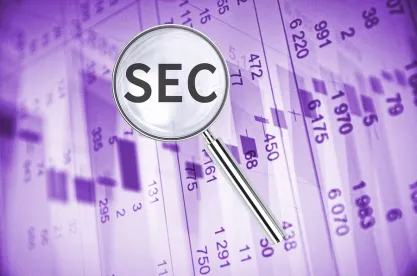On Sept. 26, 2019, the Securities and Exchange Commission (SEC) announced it had adopted a new Rule 6c-11 under the Investment Company Act of 1940 (the “Investment Company Act” or the “Act”). Rule 6c-11 will permit exchange-traded funds (ETFs) that satisfy certain conditions to operate without the expense and delay of obtaining an exemptive order. The new rule is effective 60 days after it is published in the Federal Register. The new rule was proposed in June 2018 after an earlier version of the rule first proposed in 2009 was not adopted.
In connection with the adoption of new rule, the SEC also announced that one year after the effective date of the new rule, prior ETF exemptive relief granted to provide relief related to the formation and operation of an ETF will be rescinded. However, the SEC did indicate that portions of the prior ETF exemptive orders allowing funds to invest in ETFs in excess of statutory limits are not being rescinded, and the SEC will continue to grant similar relief to newly formed ETFs upon application to the SEC. Prior exemptive relief related to unit investment trust (UIT) ETFs, leveraged and inverse ETFs, share class ETFs, and non-transparent ETFs also will not be rescinded, as such ETFs cannot rely on the new rule.
Conditions for Reliance on the New Rule
Listing on a National Securities Exchange and Issuance and Redemption of Shares. As is the case for ETFs currently operating under exemptive relief, ETFs relying on the new rule must be listed on a National Securities Exchange and must issue and redeem only in creation units to and from authorized participants in exchange for baskets and a cash-balancing amount (if any).
However, the new rule will not mandate a maximum or minimum creation unit size, or otherwise place requirements on creation unit size.
Baskets. The new rule requires an ETF to adopt and implement written policies and procedures that govern the construction of baskets and the process that will be used for the acceptance of baskets generally. In addition, the new rule allows ETFs relying on the rule to use “custom baskets” if their basket policies and procedures: (i) set forth detailed parameters for the construction and acceptance of custom baskets that are in the best interest of the ETF and its shareholders, including the process for any revisions to, or deviations from, those parameters; and (ii) specify the titles or roles of the employees of the ETF’s investment adviser who are required to review each custom basket for compliance with those parameters.
The ability to use custom baskets has tax and other advantages for ETFs. Previously, only certain issuers and sponsors who had obtained exemptive relief before 2006 had the ability to use custom baskets, whereas newer issuers and sponsors did not. The playing field that gave only certain issuers and sponsors the ability to use custom baskets a competitive advantage over new issuers and sponsors has been leveled with the issuance of the new rule.
Portfolio Holdings Disclosure and Other Website Disclosure. The new rule requires an ETF to disclose the portfolio holdings that will form the basis for the ETF’s next calculation of net asset value (NAV) per share each business day before the opening of regular trading on the primary listing exchange of the exchange-traded fund shares. On a daily basis, an ETF must disclose the following information on its website, free of charge, for each portfolio holding: (1) ticker symbol; (2) CUSIP or other identifier; (3) description of holding; (4) quantity of each security or other asset held; and (5) percentage weight of the holding in the portfolio.
The new rule also requires the following information to be disclosed publicly and prominently on an ETF’s website:
-
NAV per share, market price, and premium or discount, each as of the end of the prior business day;
-
A table and line graph showing the number of days the ETF’s shares traded at a premium or discount during the most recently completed calendar year and calendar quarters of the current year;
-
For ETFs whose premium or discount was greater than 2% for more than seven consecutive trading days, disclosure that the premium or discount was greater than 2%, along with a discussion of the factors reasonably believed to have materially contributed to the premium or discount. This information must remain on a website for at least one year following the first day it was posted; and
-
Median bid-ask spread over the most recent 30 calendar days, calculated using the national best bid and national best offer.
Marketing and Intraday Indicative Value (IIV). Unlike existing ETF exemptive relief, the new rule does not require an ETF to: (i) identify itself in its sales literature as an ETF that does not sell or redeem individual shares, or (ii) explain that investors may purchase or sell individual ETF shares through a broker via a national securities exchange.
The new rule also does not require ETFs to disseminate an intraday estimate of their NAV per share (an “intraday indicative value” or “IIV”) as a condition for reliance on the rule.
Recordkeeping
The new rule requires ETFs to preserve and maintain copies of all written agreements between an authorized participant and the ETF (or one of the ETF’s service providers) that allow the authorized participant to purchase or redeem creation units.
The rule also requires an ETF to maintain records for at least five years, setting forth the following information for each basket exchanged with an authorized participant: (i) ticker symbol, CUSIP or other identifier, description of holding, quantity of each holding, and percentage weight of each holding composing the basket exchanged for creation units; (ii) if applicable, an identification of the basket as a “custom basket” and a record stating that the custom basket complies with the ETF’s custom basket policies and procedures; (iii) cash balancing amounts (if any); and (iv) the identity of the authorized participant conducting the transaction.
Form Amendments
In connection with the new rule, the SEC also is adopting certain corresponding disclosure amendments to Form N-1A, Form N-8B-2, and Form N-CEN, as well as technical amendments to Form N-CSR, Form N-1A, Form N-8B-2, Form N-PORT, and Regulation S-X. Corresponding amendments to Form N-1A, Form N-8B-2, and Form N-CEN will be effective one year following the effective date of the new rule. All registration statements, post-effective amendments, and reports on these forms filed on or after this date must comply with the amendments.



 />i
/>i

